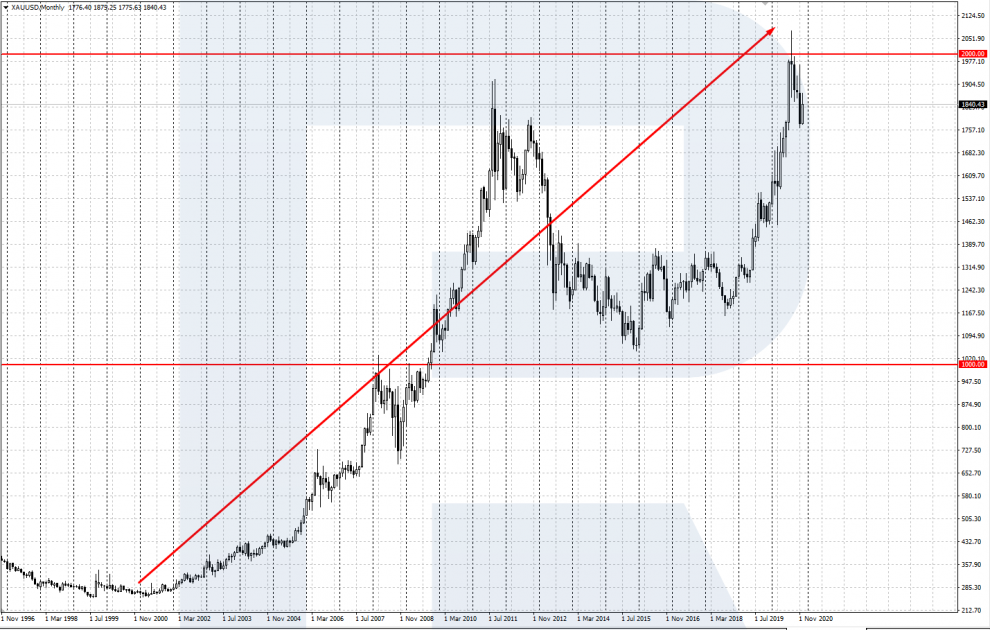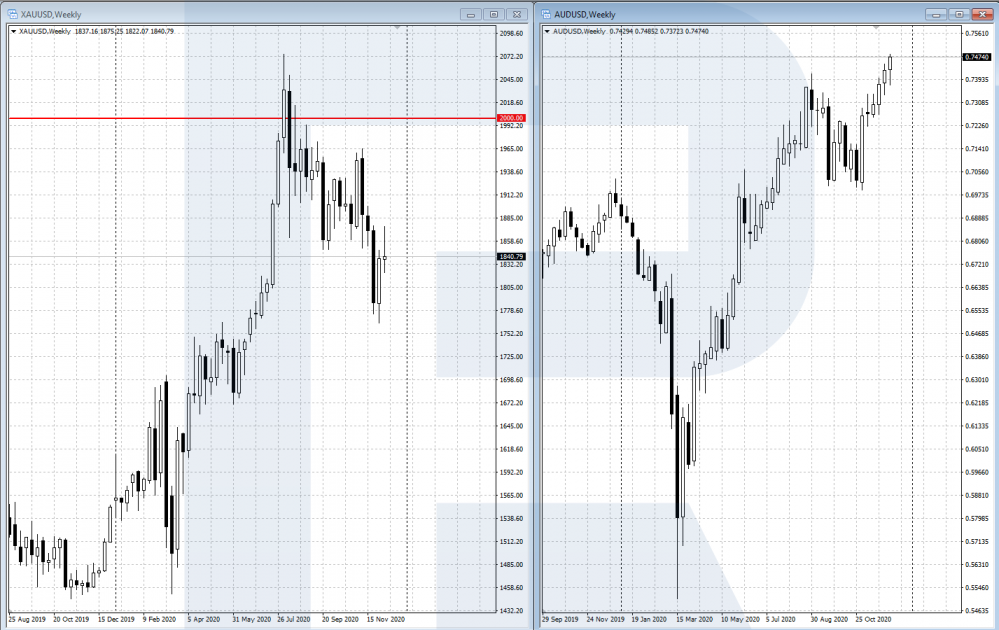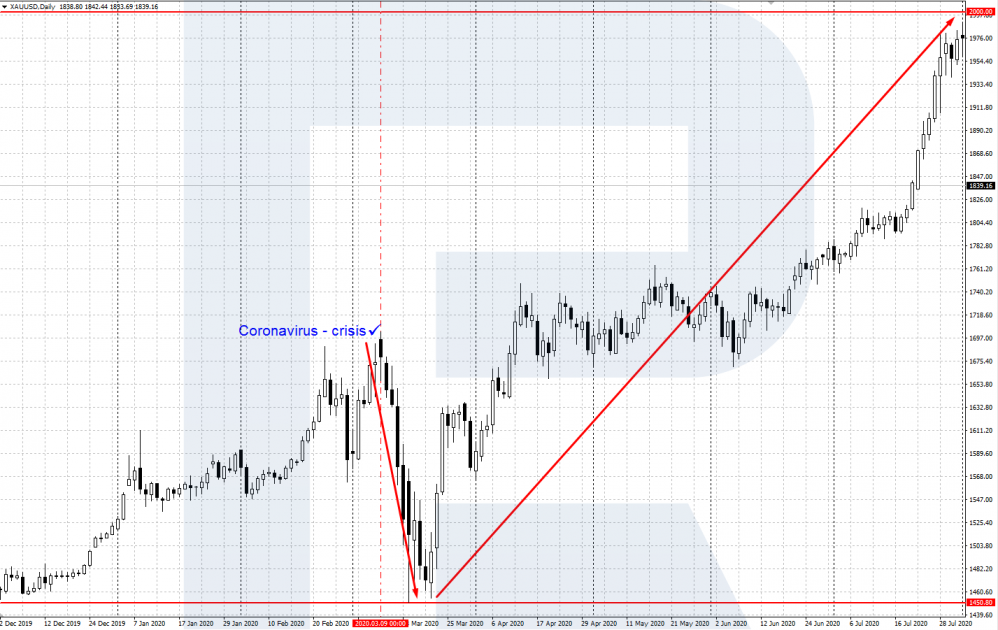How Does Gold Influence on Forex?

5 minutes for reading
Gold is one of the first metals that people learned to mine, process, and use. First gold artifacts belong to the pre-dynastic period in Ancient Egypt, i.e. about 5000 B.C. Thanks to being beautiful, rare, and durable, gold has always been used as a universal exchange means, an analog of money.
In this article, we will discuss how the fluctuations of gold quotations influence the prices on Forex.
Gold standard
The gold standard is a monetary system that emerged as a result of the wide use of gold as a universal currency. The gold standard guarantees that all the issued money can be exchanged for the corresponding amount of gold on demand. In transactions between countries that use the gold standard a fixed exchange rate of the currencies is used, based on the standard.
The gold standard that was in force after WW2 was accepted at a conference in Bretton Woods. According to the international agreement, the USA was committed to providing for the gold standard of 35 USD per troy ounce of gold. Only countries represented by their Central banks got the right to exchange dollars for gold. So, at that time the USD was really supported by gold and acquired the status of the global reserve currency.
The epoch of the gold standard ended in 1971 when the USA abandoned the free exchange of the USD for gold. The main reason for the collapse of the Bretton Woods system is the excessive quantity of dollars issued by the USA that were not supported by gold anymore. Since then, the amount of dollars in the world economy keeps growing, currency rates are set by the market, while gold is growing more expensive every year, renewing all-time highs.
This year, gold set another record, rising above 2,000 USD per troy ounce. And the growth of gold is likely to continue because the USA keeps printing dollars and pouring them into the global economy.

Which currencies are influenced by gold?
The price of gold can influence the rates of almost all currencies. Changes in the demand for and supply of gold affect the USD firsthand because the price of gold is usually given in the USD. Also, the dynamics of gold prices significantly influence those countries that produce the metal at a scale, important for their economies.
The US dollar
As long as the US dollar is currently the main global reserve currency, the price of gold is conventionally given in the USD. Gold and the dollar have inverse correlations: if the dollar falls, gold grows, and if gold falls, the dollar grows. Gold is often considered to be a means of protection from inflation: the former grows alongside the latter. The growth of the world gold reserve might drive the USD down.
Currencies of gold-producing countries
Currencies of gold-producing countries are influenced by the fluctuations of the gold price more than any other currencies. Countries that export gold and have serious gold reserves get their currencies supported by the growth of the gold price. And vice versa: when the price for the precious metal decreases, the currencies feel some oppression.
The strongest influence is experienced by the currencies of those countries in the economy of which gold production takes up a significant part. Conversely, if gold mining composes a small part of the economy, the currency will not react to the changes in the gold price so dramatically.
At the end of 2019, the largest gold producers were:
- China – 426 tons of gold. The national currency is yuan (CNH).
- Australia – 295 tons of gold. National currency – Australian dollar (AUD).
- Russia – 270 tons of gold. National currency – ruble (RUB).
- USA – 230 tons of gold. National currency – US dollar (USD).
- Canada – 175 tons of gold. National currency – Canadian dollar (CAD).
Among these countries, the AUD experiences the most influence from the fluctuations of gold. Australia is among the leaders in gold production and proven gold reserves. Also, gold production is one of the key branches of the Australian economy.

The role of gold in crises
During economic and geopolitical crises, gold is likely to grow because trust in currencies decreases. Gold is, in essence, the oldest universal currency, not bound to any national currency. Gold is the most important indicator of global economic and political development.
Beginning crises usually entail a slump in the stock market. As a rule, this pushed gold prices upwards. Investors, getting rid of declining stock assets, buy gold to decrease the risks of their investment portfolio, and get protection from the falling of currency rates.
Steep declines might cause a short-term opposite effect: to cover up for their losses, investors sell gold from their reserves, increasing the supply in the market, dropping its price, and thus pushing the USD up. However, gold resumes growth soon afterward.
All in all, slumps of stock market send money flows to protective assets: gold, the Japanese yen, Swiss franc, bonds, etc. Most currencies go down in pair with gold until the situation in the global economy stabilizes.

Summary
Gold keeps influencing global Forex industry though the gold standard does not exist anymore. The metal is actively used as a protective asset and an alternative to currencies during crises. The currencies of those countries that have a large part of their economies depending on gold production, experience the largest influence from the fluctuations of the gold price.







